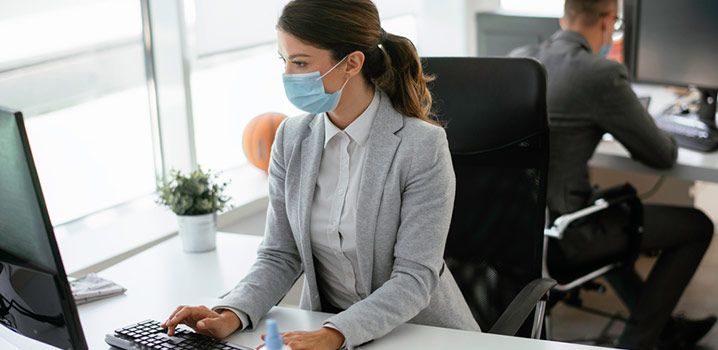Businesses across the U.S. are finally beginning to reopen their doors. As they do, creating a COVID-19 safety plan for office returns becomes the priority to prevent real and perceived risks.
COVID-19 office reopening plans and office safety guidelines have become paramount concerns for many employers. Implementing an effective post-coronavirus office policy means 40 percent of employees will be most likely working from home. At the same time, others will abide by the protocol for social distancing in the office.
4 Basic Elements of a COVID-19 Office Reopening Plan
Here are some of the basic elements of the post-COVID-19 office safety guidelines, per the CDC.
1. Check Building for Occupancy Readiness
Evaluate your building and its premise and other systems to ensure that it’s ready for reopening and occupancy. Check for any health and safety hazards related to prolonged closure such as mold growth, pests, and rodents, etc. and take adequate remedial actions.
Because COVID-19 is a respiratory disease, make sure that your facility’s ventilation systems are working properly. Improve outdoor air circulation by opening doors and windows if possible, and use fans to circulate air. However, do not open the doors and windows if it poses a threat to your employees’ health.
2. Undergo Hazard Identification and Assessment
As an employer, it is your responsibility to provide a safe and healthy working environment for your employees. Therefore, conduct a thorough hard risk assessment of your facilities to identify potential hazards that may facilitate COVID-19 transmission.
It is a good strategy to observe the COVID-19 transmission in your locale and decide how stringent and thorough you should be in your assessments. This will help you implement effective preventive measures to avoid any contagion incident.
Develop Special Rules for High-Traffic Areas
Focus on common and high-traffic work areas where employees may come in close contact with each other such as meeting rooms, cafeteria, break rooms, check-in areas, locker rooms, waiting area, entry, exits, etc.
Additionally, if you have contractors working in your building, it is your responsibility to develop and communicate new post-COVID processes and safety guidelines to them.
3. Develop Hazard Controls
Develop and establish a hierarchy of hazard controls such as modifying or re-adjusting furniture, seating arrangements, and workstations, etc. Ensure wherever your employees sit or work, they always follow a six-feet social distancing protocol. If necessary, install transparent physical barriers to separate employees.
Use tape marks, signs, and other visual identifiers such as colored tapes or decals on the floor 6 feet apart. This will show your employees and visitors where to stand when there are no physical barriers in place.
Replace items such as coffee pots and vending machines with single-serve items. Encourage your employees to bring their own water to minimize using high-touch communal fixtures such as water fountains and coffee and vending machines.

Other controls may include:
- Develop a response plan for preparedness against infectious disease.
- Define protocols for basic infection prevention.
- Establish procedures to identify and isolate sick employees.
- Develop, deploy, and communicate workplace protection and flexibilities to your employees.
- Install high-efficiency equipment such as air filters.
- Install physical barriers such as sneeze guards
- If you serve customers, then install drive-through counters for them.
- Establish practices to maintain social distancing in the office by allowing extra shifts or alternate working days to reduce the number of employees on the floor per day or per shift.
Administrative Controls
In case any of your employees have COVID-19 symptoms, encourage them to notify their supervisor and stay at home. In case if an employee becomes sick at work, separate them from the rest and provide them a face mask (if they are not using one).
Educate your employees to follow CDC office safety guidelines, and they must not return to work until they get clearance by their healthcare provider to discontinue self-isolation.
Ask your housekeeping staff to disinfect and clean high-touch surfaces continuously.
4. Provide COVID-19 Office Safety Training for Employees
Only establishing and executing COVID-19 safety plans for office return is not enough; you will have to continuously train your workforce to abide by those policies.
Consider using a train the trainer concept to teach your managers to observe their teams and conduct regular coaching. This will ensure that practicing COVID-19 safety guidelines for office becomes a second habit of all the employees.
Safety By Design Can Help Develop Your COVID-19 Office Reopening Plan
If you are about to resume business operations post lockdown but are unsure about developing COVID-19 safety guidelines for office, you can seek professional assistance. Safety by Design is a team of Houston safety consultants with years of experience in providing and designing health and safety guidelines for various industries. We even offer online OSHA training to help preserve the safety of your team while teaching them to remain OSHA-compliant.
Contact Safety by Design today and discuss how we can facilitate designing a COVID-19 office reopening safety plan for your business.



